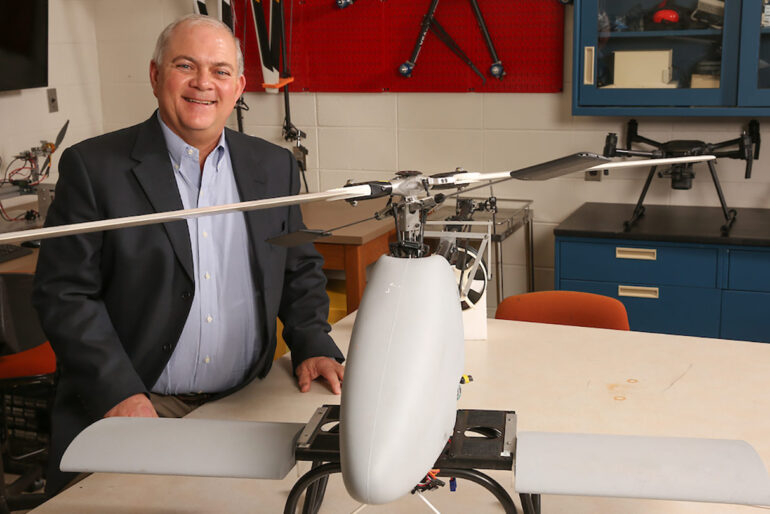Photo: Jerry Hendrix named new UAH Rotorcraft Systems Engineering and Simulation Center Director. (Michael Mercier | UAH)
APR 25, 2023 | Russ Nelson
The University of Alabama in Huntsville (UAH) tapped Jerry Hendrix as the new UAH Rotorcraft Systems Engineering and Simulation Center (RSESC) Director to replace departing David Arterburn, who recently retired after serving the center as director since 2013. Hendrix brings a wealth of expertise to his new role, along with a wide-ranging familiarity of the needs and mission of the center, thanks to his previous position as director of Unmanned Aerial Systems (UAS) programs for the same group over the past four years.
The UAH RSESC is a multifaceted research center established in 2003 as an initiative between UAH and the Aviation and Missile Research and Development and Engineering Center. The center focuses on rotorcraft hardware and software systems engineering and integration to solve the problems presented by today’s advanced technology and mission requirements for ground and airborne systems, unmanned aerial systems and space and airborne payloads.
“These areas rank among the top needs of the U.S., and our primary research will be applied to provide warfighter assistance,” Hendrix says. “With UAH ranked sixth in aeronautical and aerospace research and development expenditures, according to the National Science Foundation Higher Education Research and Development survey, we stand at a transformational crossroads of research expansion. Particularly, our research at the center will focus on advanced assured autonomy, precise navigation and timing, new rotorcraft, intelligent teaming and the many aspects of unmanned aircraft systems and counter-unmanned aircraft systems.”
Prior to coming to UAH, a part of The University of Alabama System, Hendrix was executive director for the Lone Star UAS Center of Excellence and Innovation where he worked for Texas A&M University System in Corpus Christi, TX. His aerospace experience includes stints with Boeing, L3 Communications and Huntington Ingalls Industries as well, comprising over 35 years supporting Federal Aviation Administration, NASA and Department of Defense missions.
“Growing our center is the number 1 challenge at this time,” Hendrix notes in detailing what he sees as the most important need of the RESEC to continue its high level of accomplishment. “Student support, engineering discipline and targeted internal research are critical so we can be in touch with the Huntsville community to better serve customers and raise student capabilities.”
Since its inception, the center has blossomed to 45 full-time employees, 20 on-call employees and 70 students, of which 53 are working at the Boeing Design Center South. The group boasts significant capabilities in Vertical Lift and Unmanned Aircraft Systems, systems engineering using Model Based Systems Engineering, design and system analysis, rapid prototyping, integration and fabrication to support government and industry rotorcraft partners. The center also works with the Association of Uncrewed Vehicles Systems International UAH Student Chapter and UAH’s Space Hardware Club. Research laboratories under the direction of the center include the Requirements Failure Analysis Lab, UAS Lab, Swarm Autonomy and Research Engineering Lab and three controlled Computer Systems Integration Labs for systems engineering.
“The existing culture and breadth of our research capabilities is broad and well beyond just rotorcraft engineering,” Hendrix notes, in considering the future goals of the RSESC going forward. “The center will conduct research on behalf of the aerospace community in Huntsville and the nation, focusing on advanced solutions. This vision broadens our support from rotorcraft across Unmanned Aircraft Systems and Counter UAS to autonomy and digital transformation. We are already seeing growth in the autonomous work and robotic work coming to the center.”
The RSESC provides students an opportunity to work alongside researchers and engineers to obtain vital real-world experience. In addition to its rotorcraft activities, center personnel have established a long track record of supporting industry and government organizations in space mission analysis and the design, qualification and fabrication of space- and aircraft-mounted payload systems.
“It is our goal to become a national premier autonomous aerospace research center, addressing these needs for our customers, while allowing our students to excel in top research areas,” Hendrix explains. “To facilitate this research, we will use our key experts with the fundamental aspects of engineering/tests, while supplementing system understanding with digital engineering. This will position UAH for millions of dollars of research supporting federal agencies and commercial enterprises.”

